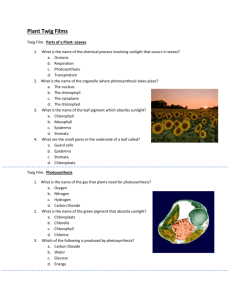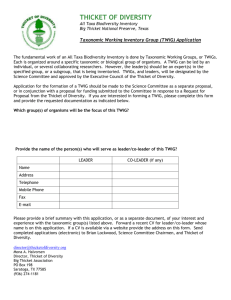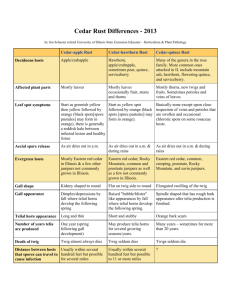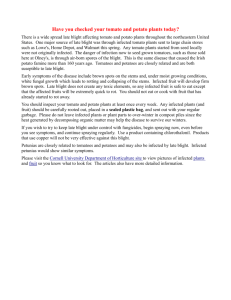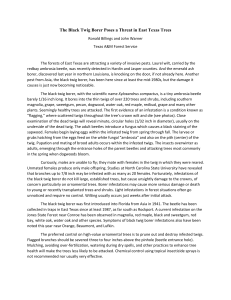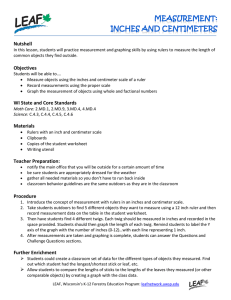--e- r- h-.---1n the- ____
advertisement
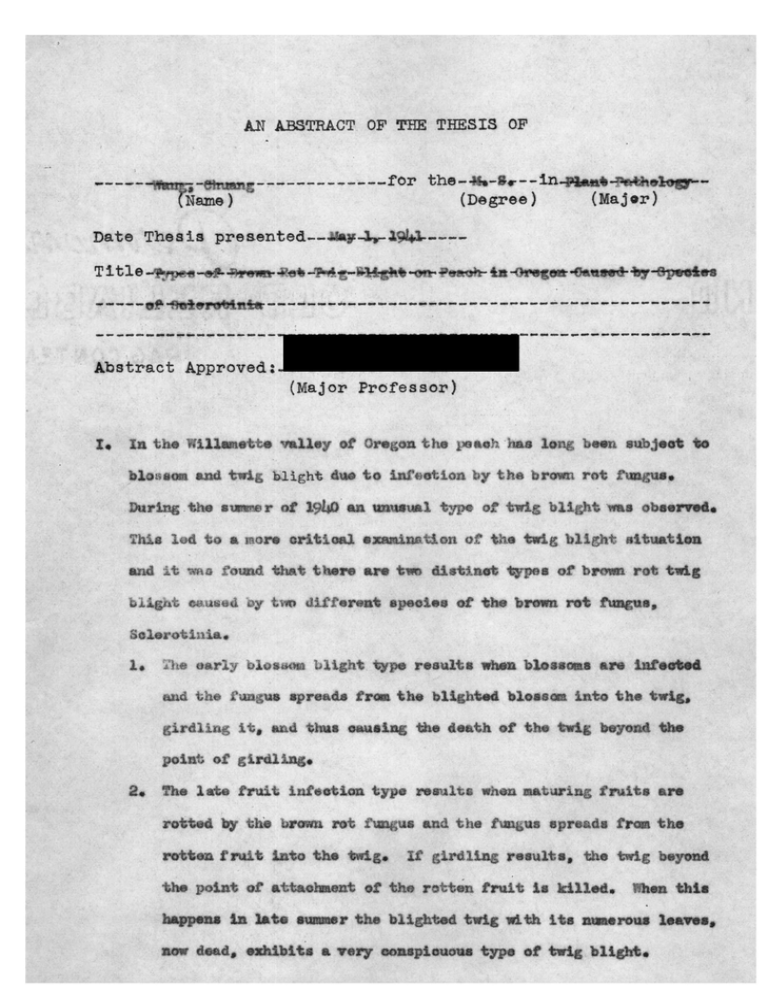
AN ABSTRkCT OF TEE THESIS OF - fOr the- h-.---1n ____ (Maj*r) (Degree) ÇNaDIe) Date Thesis presented--..43.,-3Ç4].----T i-tie --e- r- xt _________________________________________________ Abstract Approved: (Major Professor) X. Irt the W ti1Eøtte b13HOn an t*riç id sud it bi4t blight r of During the This of Orern the **oh hae 1on been duo tere fcnmd that tm 01Lu584 by th brown sxazition rot f uztu., b1iht 19WJ ai wtsua1 typc of twig to * moro critloal tG to infotion of the twt aubjeat to w observed. b11ht dtustion dit&net types of bremi rot twig re t 4ttt.r.nt speoies of the brown rot fungus, Salerotiiiia. 1. hf er]y b1o*m funua ird1ing it, blight type reaulta when b1ossn.s reflda f rc*n 3 ud thus th ousin b1iht.d inteubed blossoet into the twig, the datth of the twig beyond the point of girdling. 2. The l*te frwt infection type rotted b s1t Uil trown rot fti;ue and rotten fruit into the twig. ttie wei t.urìng fruits ere funus eprcdc from the If girdling results, the twig. beyond the point of a.ttohmezit of the rotten fruit is dIled. h.spp.ns in n 1to swnzner the blighted twig with its Thon this uerous dead, exhibits a very conspicuous type of twig blight. leaves, &batrot (eonttnd) nl'erabl II. eri&1 w.s oo11cted and cultured and from thia lt t wan detertnod that the t*, typen of 1arely though not antire1 bltht aro caised qu.te by twG diffrent npeois of t.e brown rot f unus. of the !ost 1. ca4y bloior type 'clerotinit laxa, wore due to thin - ,. 2. - In the f erial peoen and only of blight tuc1tcd 96 i rtre caused by of the mn due to another speoin, fruotloals. the otbr type were ty4eøtioxi hand raost cacen, 71%, of the lato fruit infection *uaed by by. laxa S. fruoticola, irhiie 2ï! were due to TYPES OF BROWN-ROT TWIG-BLIGHT ON PEACH IN OREGON CAUSED BY SPECIES OF SC LERO TI NIA by WANG, CITUANG A THESIS submitted to the OREGON STATE COLLEGE in partial fulfillment of the requirements for the degree of MASTER OF SCIENCE June 1941 APPROVED: Professor of Botany In Charge of Major Head of Department of Botany Chairman of School Graduate Committee Chairman of State College Graduate Council AC KNO WLEDGMENT S I wish to express my appreciation to Dr. C. E. Owens, Dr. S. M. Zeller, Dr. T. C. Llu, Mr. A. J. Braun and Mr. A. W, Evans for assistance of various kinds in carrying out this investigation and pre- paring the thesis. Dr. Owens is largely responsible for the detailed correction of the thesis. Thanks are due the following farm owners for per- mission to collect material for study from their peach orchards: George Hesler, J. H. Tompkins, Louis Will and C. A. Rockhill of Yanthill County, and W. L. Powell of Benton County. Contents I ntrod.uc tian . ................. . Review of Literature . . . . . . . . . . . . . . Occurrence of two Types of Twig Blight in Oregon Page i . . 2 . . 5 Early Blossom-infection Type Late Fruit-infection Type ßource of Material . . . . ..... . Method of Determining Species . Species of 3clerotinia Concerned Percentage of Literature Cited . . P lates . . . . . . . . 7 . . . . . . . . . . 7 . . . . . . . . . . 8 . . .10 ch bpecies in Liaterial Summary and Conclusions Tables . . . . . . . . tudled . . . . . . . . . . . .10 . . . . . . . . . . . .12 . . . .13--30 . . . .31--33 ............ ............... . . . TYPES OF BROWN-ROT TWIG-BLIGHT ON PEACH IN OREGON CAUSLD BY SPECIES OF SCROTINIA Introduction Brown rot, caused by species of Sclerotinia, is an important disease of stone fruits in Europe, America, and various other parts of the world. In Europe and especially in Britain the pome fruits also are seriously attacked by certain species. In America the ponie fruits are sometimes affected but here the trouble is primarily one occurring on stone fruits. The occurrence of a twig blight on peaches in Oregon due to the brown rot fungus has been observed over a period of many years. The conionly occurring type of blight is that resulting from blossom infection and affects a relatively short length of twig, usually killing from about two or three to five or six inches of the terminal part of the twig. During the late sunnner of 1940 a type of twig blight was observed which apparently resulted from the spread of the brown rot fungus from rotting fruits into the twig. Many twigs were girdled at the point of attachment of the rotting fruit thus killing all the twig growth beyond this point. 2 The purpose of this investigation was to determine the species of Scierotinia causing these two types of twig blight, the one resulting from the early blossom infections, the other from the late fruit infections. Review of Literature Since the time of Persoon, who published what appears to be the first authentic description of any of the brown rot fungi under the name Torula fructigena (9), and later Monilia fructigena (10), considerable confusion has existed in both Europe and America as to the exact identity of the various of disease. species of Scierotinia causing this type Not until Harrison (4, 5) made a thorough review of the literature and studied all of the material available in Europe, America, and Australia was the con- fusion cleared up and the identity of the several species clearly established. From Harrison's work it appears that there are three distinct species of Scierotinia causing a "brown rot" disease of fruits, as follows: S. (a) fructigena (Ader. and Ruhi.) causes fruit rot of both pone and stone fruit in Europe and the British Isles. is said to occur also in China and Japan. (b) S. It laxa (Ader. and Ruhi.) causes fruit rotting mainly in the stone fruits, but also causes blossom blight, twig and spur blight, and twig canker in stone fruits and sometimes in 3 pears and quinces as well. Europe, Britain, of North America. This species is known in China, Japan, and the Pacific Coast region (e) S. fructicola (Wint.) Rehm., commonly referred to as the American brown rot fungus, causes fruit rot, but may also cause blossom and twig blight and canker on most stone fruit trees. occasionally affect pone fruits also. It may This species is known to occur throughout North America and is the only brown rot fungus found in Australia and New Zealand. Since Harrison has so thoroughly reviewed the literature this account will be confined to the situation on the Pacific coast of North America and particularly to Oregon and California, where both S. fructicola and S. laxa are known to occur. Apparently the brown rot disease has been known in Oregon since the latter part of the 19th century when Hedrick (6) reported it on prunes. It apparently was not suspected that there night be more than one form present in this state until Barss and Posey made a study of strains collected on various stone fruits, pears, and quinces, and became convinced that there were two distinct strains, or possibly species, occurring in Oregon. Posey (li) wrote a master's thesis on the subject which was mitted in 1915. Thj sub- thesis was not published but a brief 4 abstract covering the essentials of this investigation was published In Science, October 22, 1915. Barss (i) later published a circular on brown rot in Oregon and suggested the naine iJonilia oregonensis for the strain which differs from the common American brown-rot species, since at that time the confusion over the various species occurring in Europe and America had not yet been cleared up. As in- dicated above, Harrison has since demonstrated that this form is identical with the European S. laxa. states that the ttordinarytT brown rot fungus, Barss further now known to be the American brown-rot species, S. fructicola, causes the severe attacks of fruit rot of stone fruits in Oregon, and also causes blossom blight as well. On the other hand he states that the newly described species, now known to be S. laxa, causes very severe attacks of blossom and spur blight and twig cankers on all kinds of stone fruits and on certain varieties of pears. However, the latter species causes less rotting of fruit than S. rructicola according to Barss. No apothecia of S. laxa have ever been found in Oregon, but those of S. fructicola are common. In California Bioletti (2) published the earliest account of brovm rot of fruits. Other accounts of the occurrence of brown rot in California were published by Smith (13), Howard and Home (8), and Rudolph (12). These earlier writers mentioned both fruit rot and blossom and 5 twig blight but gave no indication that they suspected the presence of two species of brown rot fungi. No apothecia of Scierotinia were reported by any of these writers. Smith called attention to the blossom and twig blight and Rudolph emphasized this phase, especially on apricots. Rudolph sent specimens to Ezekial both S. (3) who described laxa and S. fructicola thus indicating that at that date both species were present in California even though no one had reported apothecia up to that time. Hewitt and Leach (7) were the first to definitely Apothecia of report S. fructicola from California. Selerotinia fructicola were found in California in 1936, apparently for the first time. According to them S. laxa is still the most widespread species in that state, causing blossom and twig blight and also fruit rot of apricot, prune, nectarine, peach and cherry. S. fructicola occurs in many localities but apparently is not very abundant except in certain circumscribed areas such as the Sacramento valley. Occurrence of Two Types of Twig Blight on Peach in Oregon Two types of brown rot twig blight on peaches have been observed in the Vvillamette valley of Oregon, namely the early type entering through blighted blossoms, and the late type entering from rotted fruits. The typical twig bUCht resulting from blossom infec- tion appears shortly after blossoming, sometinies before the terminal tuft of leaves is full grovm and before new shoot growth has proceeded very far. Any blossom on a twig may be killed by the brown rot fungus and in many cases the fungus grows from the blossom back into the twig and girdles it. Vhen this happens that part of the twig beyond the girdle dies, giving rise to the common and often observed twig blight (Plate I). The length of twig killed depends upon which blossom is infected. If the girdle results from ïnfection of a blossom near the tip of the twig the blighted tip will be quite short. On the other hand if a blossom near the base of the blossom- bearing shoot is infected and results in girdling, a longer length of twig will be killed. It is usually quite easy to identify this early, blossom-type of twig blight. Often the blighted blossom dries up and hangs on, or if it falls off, the girdling canker will be located at the node where the blossom occurred and the relationship can always be recognized. Twigs blighted by the brown rot fungus have a characteristic appearance which can be recognized with considerable certainty. The late tipe of brown rot twig blight appears when the fruit is nearly or quite mature and results when the 7 fungus migrates frani a rotted fruit back through the pedicel and girdles the twig. Twigs girdled and killed at this stage are usually longer and more conspicuous than the twigs blighted earlier because, at the later date, the new, current season's twig growth has developed and therefore there is a much longer extension of twig beyond the point where the rotten fruit is attached and where the girdling has occurred (Plate II). This additional length of blighted twig with its numerous, dead, brown leaves is quite conspicuous, and in serious cases the tree may be covered with these dead twigs or tTflagsU which are visible for comparatively long distances. Source of Material Material for this study was collected during the fall, winter, and spring of 1940-41 fron several localities in the illamette valley of Oregon. Orchards from which specimens were collected include the following: Yanthill County:: George Hesler, Dayton J. H. Tompkins, Grand Island Louis Will, Grand Island C. A. Rockhill, Grand Island Benton County: I, L. Powell, Kiger Island Ilethod Used in Determining Species The species concerned in each determined by the culture method. te of blight was Barss, Posey, Harrison, Hewitt and Leach, and others have noted that each species of Scierotinia causing brown rot has its own character- istic appearance when grown upon potato dextrose agar and other media. The fungus concerned was isolated by the ordinary method; i.e., sterilizing the surface of the diseased twig with mercuric chloride, l-1000, then, with sterile instruments, removing bits of the diseased tissue from beneath the bark and plating on agar. Plate III shows the characteristic growth of S. fructicola and S. laxa on potato dextrose agar and on Cook's agar in Petri dishes. It will be noted, as many previous investigators have observed, that the former makes a much more rapid and luxuriant growth than the latter. S. fructicola makes a uniform growth with conspicuous concentric rings. The niycélial mat is covered with a dense growth of conidio- phores and conidia giving the zoned surface an ashy gray color and a very fluffy and pulverulent appearance. S. laxa, on the other hand, grows slowly, in an irregular manner, has a whiter color and does not produce such conspicuous concentric zones as does S. fructicola, and pro- duction of conidia is very scant. Species of Scierotinia Concerned These studies showed that the two species associated with the types of twig blight concerned were and S. laxa. S. fructicola There were 244 specimens collected and one to four attempts at isolation were made from each specimen. Many of the tissue plantings failed to produce a growth of Scierotinia but from the total number of specimens from which attempts to isolate a fungus were made, one or more cultures were secured from 154 different blighted twigs. Table i shows in detail the number of specimens collected, place and time of collection, attempts at isolating the fungus, and the species isolated in each te case from the early type or late tively. of twig blight respec- The tabulation shows that in a great majority of cases the early or blossom infection type yielded cultures of S. laxa while the late or fruit type of blighted twigs yielded a high percentage of Table 2 S. fructicola. gives a summary of the incidence of the two species of Scierotinia on the two types of blighted twigs. At least on peaches these studies confirm the statement of Bars s that most of the blossom blight is caused by S. laxa while most of the fruit rot is caused by S. fructicola. Thj conclusion is based upon the fact that of 82 twïgs lo showing the early or blossom infection type of blight 79, or 96 percent yielded cultures of S. laxa while only 3, or 4 percent gave cultures of S. fructicola. On the other hand, of 72 twigs exhibiting the late or fruit infection type of blight 51, or 71 percent gave S. fructicola and 21, or 29 percent yielded S. laxa. There is a possibility that the high percentage of S. laxa secured in cultures made from the late or fruit infection type of blighted twigs may be due to error in determining the identity of species because of contsminated cultures. Suimnary and Conclusions 1. Two types of twig blight due to infection by species of Sclerotinia have been observed on peaches in Oregon, an early type resulting from blossom infection, and a late type caused by the spread of the fungus from rotten fruits into the twigs. 2. Cultures of the causal fungus isolated from the two types of blighted twigs revealed that two different species of brown rot fungi were concerned, S. laxa, causing nearly all of the early type of twig blight, and S. fructicola, causing most of the late type of blight. were exceptions to the rule in both cases. There 11 3. Of a total of 82 cultures secured from the early or blossom-infection tipe of blighted twigs, 96 percent were S. laxa, while of 72 cultures isolated from the late or fruit infection type of blighted twigs, 71 percent were S. fructicola. 4. Based upon the data secured in these investiga- tions it is concluded that nearly all of the blossom in- fection type of twig blight on peaches in the Willamette valley, Oregon is caused by S. laxa, while the late or fruit rot type is caused quite largely by S. fructicola. 12 LITERATURE CITED 1. Barss, H. P. Brown rot and related diseases of stone Ore. Agr. Exp. Sta. Cir. 53. 1923. fruits :in Oregon. 2. Calif. Agr. Bioletti, F. T. Brown rot of stone fruits. 1902. Exp. Sta. Rept. (1898-1901) 2:330-331. 3. The Ezekial, W. N. Fruit rottinC Scierotinlas. II. American brown-rot fungi. Md. Ar. Exp. Sta. Bui. 271:87-142. 1924. 4. Harrison, T. H. Brown rot of fruits and associated Historical diseases of deciduous fruit trees. I. taxonomy concerning critical remarks review and Jour. and nomenclature of the causal organisms. S. 1933. N. a1es 67:132-177. Roy. Soc. 5. Brown rot of fruits and associated ______________. diseases of deciduous fruit trees. II. The apothecia Jour. Roy. Soc. N. S. of the causal organisms. 1934. Viales 68:154-176. 6. Brown rot of prunes. Hedrick, U. P. 1895. Sta. Bui. 47. 7. Brown rot Scierotinias Hewitt, W. B. and L. D. Leach. distribution on their California and occurring in Phytopath. 29:337-351. 1939. stone fruits. 8. Brown rot of apricots. Howard, W. L. and W. T. Home. Calif. Agr. Exp. Sta. Bui. 326:73-88. 1921. 9. Persoon, C. H. Torula £ructirena in Observ. Mycol. Lypsiae., p. 26. 1796. 10. ______________. 1801. Ore. Agr. Exp. Synopsis Methodica Fungorum p. 693. B. Studies of Lionilia blight of fruit trees. 1915. Science N. S. 42:583. 11. Posey, G. 12. Rudolph, B. A. Lionilia blossom blight (brovm rot) of 1925. apricots. Calif. Agr. Exp. Sta. Bul. 383. 13. Smith, R. E. Report of the plant pathologist to July 1, 1907. Calif. Agr. Exp. Sta. Bui. 184. 1906. TABLE 1. -- Isolations from b1ihted twigs, both early (blossom) and late (fruit) tï,e of lace of collections and host variety, infection, showing the number and date of collections, which a brovm rot organism was rein instances of attempted, number number of isolations of infection in each case. and type the present, or Sclerotinia covered, the soecies Juber and Date of Collection Place of Co1-Number of Isolations lection and Variety Attempted iost Number of Cultures Recovered i Species of Sclerotinia Present S. laxa S. fructicola Type of Infection Early lossoxn Infection j_______________ I Lete Fruit Infection Geo. Ilesler 1 2 D-28-40 u 3 0 - - - - 4 0 - - - - 3 1 x - x - " 3 2 x - x - Dayton Cling Geo. Nesler ayton Craford 3 II 4 5 " " 3 2 x - x - 6 " " 2 0 - - - - lt tI 3 2 x - x - " " 3 2 x - x - " " i O - - - - 7 8 9 TABLE 1. (Continued) 10 !'. u 3 0 - - - - 2 2 x - x - 1 x - x - 11 " 12 " " 13 " " 2 0 - - - - 14 " 3 0 - - - - 15 " 3 2 x - x - 16 " 4 0 - - - - " 2 2 x - x - " 3 2 - x - 17 " 18 1 " " 2 1 x - x - 20 " " 3 1 x - x - 21 " " 2 2 x - x - " 1 1 x - x 22 23 II 2 3.. x - x - 24 " 2 0 - - - - " 3 1 x - x - 25 " TABlE 1. (Continued) " 26 27 28 " 29 " 2 1 x - x - ii 2 0 - - - - ti 3 0 - - - - 4 0 - - - - 4 3 x - - x 4 0 - - - - 4 0 - - - - Geo. llesler 30 ' 31 " 32 Dayton E iberta Geo. Hesler Dayton Hale i 33 Ii tI 2 0 - - - - 34 ii it 2 1 x - - x 35 ii ti 2 2 - x - x ii 1 1 x - - x 4 0 - - - - 36 37 38 40 ii n it 3 1 x - x - n it 2 2 x - X - 1 0 - - - - ti al T.ABI 1. 41 " (Continued) 2 0 - - - - 3 2 - x - x 2 1 - x - x 2 0 - - - - i O - - - - 2 1 - x - x 4 1 - X - x 3 0 - - - - 3 2 - x - x 50 3 1 - x - x 51 4 3 - x - x 4 0 - - - - 3 i - x - x 3 1 - x - x 3 0 - - - - J 42 " 43 lt 44 " 46 " 47 " tl II tI 52 ft 53 55 11 tI 48 54 Grand Island Unknovm u 45 49 H. Tompkins ft 11 II ft i-J O) TABLE 1. (Coitinued) 56 2 0 - - - - 3 0 - - - - 57 H It 58 u U 4 2 - x - x 59 U H 3 1 - x - x 60 " 8 2 1 - x - 61 " 2 1 - x - 2 i - x - 62 ' 8 x 63 " 2 0 - - - - 64 " 2 2 - x - x II 3 3 - x - x 11 4 1 - x - x - x - x i - x 65 66 " 67 " 68 " 69 3 U It 70 71 lt 3 1 2 0 - - - - 3 2 - x - x 3 1 - x - x TABLE 1. (Continued) ti 2 0 - - - - ti 2 0 - - - - 2 0 - - - - 4 1 - x - x 76 3 3 - x - x 77 3 0 - - - - .72 73 u 74 ti 75 ' II H 78 " 2 0 - - - - 79 " 3 0 - - - - 80 ' 11 2 0 - - - - 81 It 3 2 - x - x 82 II 3 0 - - 83 t, 3 0 - - - - 84 tI 3 2 - x - x 85 it i - 86 ii 2 2 - x - x 2 0 - - - - 87 ti - - TABlE 1. (Continued) 88 11 C. 89 " í.. 2 1 - x - x 4 0 - - - - Rockhill Grand Is land 7jnknovm. 90 ' " 3 0 - - - - 91 " " 3 0 - - - - 92 " H 3 0 - - - - 93 tI n 3 1 - x - x 94 " " 2 0 - - - - 95 U It 4 Q - - 96 " " 2 0 - - - - 97 It lt 3 0 - - - - 2 0 - - - - 3 0 - - - - II 3 0 - - - - " tI 2 1 - x - x 't lt 2 0 - - - - tI 98 99 Ii 100 101 102 II I-J TABLE 1. 103 " 104 105 108 It 3 0 - - - - " 2 0 - - - - ' 2 0 - - - - 8 2 0 - - - - " 2 1 x - x - " 2 0 - - - - 3 1 - x - x 3 0 - - - - 106 107 (Continued) " ' L. 'i11 109 " Grand Is land Unknown 8 1.10 111 " " 2 0 - - - - 112 " " 3 0 - - - - 113 " " 3 1 - x - x 114 " 11 2 0 - 115 " " 3 2 - x - x 116 " 8 3 . - x - x 117 " 2 0 - - - - " - o TABLE 1].8 1. " (Continued) U U 119 2 1 - x - x 3 0 - - - - 3 2 - x - x 3 0 - - - - 2 1 - x - x 120 " 121 " 122 " 123 " 3 1 - x - x 124 " 2 1 - x - x 125 " " 3 0 - - - - 126 " " 3 0 - - - - " 3 1 - x - x " 2 0 - - - 3 1 - x - x 2 1 - x - x 4 1 - x - x 127 " " 128 " 129 " 130 " 131 " 132 " " 3 1 - x - x ' " 3 0 - - - - 133 " TABLE 1. 134 " 135 " (Continued) ï. 136 9-23-40 3 0 - - - 3 0 - - - 2 0 - - - " 2 0 - - - 2 0 - - - " L. Powell Kier Island Iale 137 " 138 " tt 139 " " 1 0 - - - 140 " " 2 1 x - - X 141 " " 2 2 x - x X 142 " " 1 0 - - - " 1 1 - x - 2 1 x - x 143 144 n 145 tt 1 0 - - - 146 " i O - - - " i O - - - tt 2 0 - - - 147 " 148 " X TABLE 1. (Continued) 149 It 2 0 - - - 150 " " 2 1 - x x 151 " " 2 2 x - x i i - x X 2 1 x - 1 - x - - - - U 152 I. 153 " Powell L. Kiger Islarul 2lberta 154 tI 3 155 tI 2 tt 156 157 158 " U It 159 160 16]. 162 163 " " " Ii 2 1 x. - x 2 0 - - - 3 1 x - x 2 1 x - x 3 2 X - X 2 2 x - x 1 1 x - x 1 1 x - x X TABLE 1. 164 " (Continued) W. L. Powe11 Kier Island Crawford It 166 ' 167 " 168 " It ft 2 0 - - - - 2 1 x - - x 1 1 x - - x 2 2 x - - x 2 2 - x - x 169 " 2 Q - - - - 170 11 2 1 x - - x 171 " 2 0 - - - - 172 " 2 1 x - x - 173 " " 2 0 - - - - " W. L. Powell Kiger Island Slappy 2 1 x - x - 175 2 0 - - - - 176 3 1 x - x - 177 1 3. x - x - 174 t', TABLE 1. 178 " 179 (Continued) " i i x - x 11 1 1 x - x 2 2 - x x 2 1 x - x 180 " 181 " 182 " 2 1 i - x 183 " i i x - i 184 " 2 2 i - x 185 " i O - - - 186 " 2 2 x - x 187 " 2 i x - i 188 " 2 2 i - x 189 " 2 2 i - x 190 ', 2 0 - - - 19]. " 2 2 i - i 192 " i O - - - 193 " 2 0 - - - " O) TABLE 1. (Cpntinued) 1.94 1 " L. Powell Kiger Island Rochester 2 1 x - x - 2 2 - x - x 2 1 - x - x 3 1 x - - x 2 1 - x - x 2 2 x - - x t. 195 " 196 U 197 198 " 199 200 " 3 3 x - - x 201 " 3 1 x - - x 2 2 x - x - 2 2 x - x - 2 1 x - x - 2 2 x - - x 1 1 x - - x x - - x x - - x 202 1-20-41 ao3 W. .L. .Pawell Kiger Island Unknovm " 204 ti 205 206 " 207 " i 208 " 2 1 2 TABLE 1. 209 " 210 " (Continued) " 2 2 x - x - " i i x - x - i i x - x - 21]. 212 " " i i x - x - 213 " " i i x - x - 214 3-7-41 " 2 0 - - - - 215 " " 2 0 - - - - 216 " " 2 0 - - - - " 2 1 x - - x " " 2 1 x - - x t " 3 2 x - - x 217 210 219 220 " " 2 1 x - - x 221 " 1) 2 2 x - x - 222 " " 2 2 x - x - " i i x - x - 223 T&BLE 1. (Continued) 224 i i x - x - 2 1 x - x - 2 1 x - x - H i i x - x - " i i x - x - ti 1 1 x - x - 2 1 x - x - 2 1 x - x - 2 1 - x - i i x - x - 1 1 x - x - " 225 226 ' 227 225 " 229 " 230 231 " 232 233 " 234 " H 235 it i i x - x - 236 ti i i x - x - 1 1 x - x - i i x - x - 237 ' 238 " TABLE 1. (Continued) 239 240 x - x - 2 1 x - x - 1 1 x - x - i i x - x - It i i x - x - 11 2 i x - x - 11 ' 243 244 1 " 241 242 2 1 " (O 30 TABlE 2. Percentages of S. laxa and S. fructicola isolated from the early blossom infection type and from the late fruit infection type of blighted twigs respectively. Species of Scierotinia Isolated Place of collection "rom early infected twigs $. Ceo. Hesler Dayton, Ore. laxa ¡ S. fructicola From late infected twigs fruoticola laxa S. f 19 0 3 1 0 0 0 28 Louis Villi Grand Island 0 0 0 14 Rockhill Grand Island 1 0 0 2 N. L. Powell Kiger Island 59 3 18 6 Totals 79 3 21 51 Per Cent 96 4 29 71 J. H. Tompkins Grand Island C. A. PLATE I. Peach twigs showing the early or blossom infection type of twig blight caused by Scierotinia laxa. The blighted, dried blossoms through which the fungus entered the twigs may be seen still attached to the twigs. PLATE I. PLATE II. Peach twigs showing the late or fruit infection type of twig blight caused by Sclerotinia fructicola. The rotten peaches through which the fungus entered the twigs may be seen still attached to the twigs. All of the growth beyond the girdle at the point of fruit attacbment Is dead. 32 PLATE II. PLATE III. Cultures, grown on Cook's agar, of two species Fig. 1. of brown rot fungi concerned with the two types of twig blight on peaches. Left: Culture of Scierotinia laxa isolated from a peach twig showing the early or blossom infection type of blight. Culture of Sclerotinia fructicola isolated Right: from a peach twig exhibiting the late or fruit infection type of blight. Both cultures same age. Cultures of the same two species of Sciero- Fig. 2. tinia shown in Fig. 1, but grown on potato dextrose agar. Left: Sclerotinia laxa. Right: Cultures Sclerotinia fructicola sanie age as those shown in Fig. 1. = PLATE IV. Fig. 1. Peach twig showing. the early or blossom in- fection type of twig blight with the clumps of conidiophores and conidiospores located near the tip of the twig. Fig. 2. Single spore cultures made from conidio- spores such as those represented on the twig in Figure 1. J PLATE IV. Fie. Fig. 1. 2.
